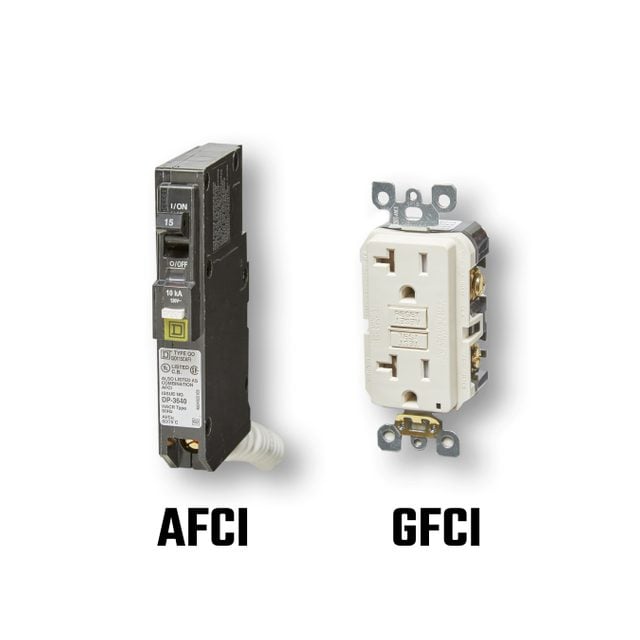Explaining the Difference Between GFCI and AFCI Protection

Ground-Fault Circuit-Interrupter Protection (GFCI)
It’s rather remarkable when you stop to think about it; 2018 was the 50th anniversary of GFCI protection in the National Electrical Code (NEC). At first, GFCI was rather a niche technology only required for swimming pools. Then it expanded to outdoor and bathroom receptacle outlets and has continued to see increased usage over the decades. Today, GFCI protection can be found in many of the places where we live, work, and play.
What Is a Ground-Fault Condition?
A ground-fault condition occurs when a current takes an unintentional path back (called a leakage current) to the source of the electricity by coming into contact with a grounded surface. For example, if the metal outer shell of the toaster oven were to become energized and someone touched it, that person could become the path for the unintentional fault current and may receive a fatal electrical shock. GFCI protection protects people from serious electrical shock injury in places where there are hazardous leakage currents from power tools and appliances. Those include locations where moisture is present such as kitchens, bathrooms, and outdoors, and places where there might be damaged electrical wiring or frayed flexible cords.
What Does a GFCI Do?
Ground-fault circuit-interrupter (GFCI) protection is intended to protect people from fatal electrical shocks by de-energizing the electricity within a very short period of time when an electrical current to ground exceeds certain values. Common GFCI devices such as circuit breakers and receptacle outlets are designed to stop the flow of electricity if the leakage current to ground is in the range of 4 milliamps (.004) to 6 milliamps (.006). All it takes is approximately 10 milliamps (.010) of electrical current passing through a human body for 2 seconds to cause death.
In short, GFCI protection is about shock protection and saving lives.
Where is GFCI Protection Required?
Compared to the first requirement for GFCI protection for swimming pools 50 years ago, today GFCI protection is required in approximately 50 locations throughout the NEC. The following is a sampling of locations where GFCI is required in one- and two-family homes and multifamily buildings:
- Bathrooms
- Garages, and accessory buildings that have a floor located at or below grade level and used for storage and work areas
- Outdoors
- Crawl spaces at or below grade level
- Unfinished portions of basements not intended as habitable rooms
- Kitchens, where the receptacles are serving countertop spaces
- Sinks, where the receptacles are within 6-feet from the top inside edge of the sink bowl
- Boathouses
- Bathtubs and shower stalls, where the receptacles are within 6-feet of the outside edge of the tub or shower stall
- Laundry areas
- Boat hoists, for outlets not exceeding 240-volts
- Kitchen dishwashers, whether they are cord-and-plug connected or hard-wired
- Crawl space lighting outlets
It’s important to refer to the NEC for a complete list of locations where GFCI protection is required. devices are required to be installed in readily accessible locations, meaning they can be reached quickly for operation, renewal or inspection.
Arc-Fault Circuit-Interrupter Protection (AFCI)
The requirements for AFCI protection first came into the NEC in the 1999 edition, with an effective date of January 1, 2002. At first, AFCI protection was only required for the branch circuits that supplied receptacle outlets in bedrooms. The delayed effective date gave the electrical industry time to refine AFCI technology, and bedrooms were deemed to be a high priority and a good place to introduce AFCI protection in our homes in an effort to prevent fires and save lives.
What is an Arc-Fault?
A hazardous, unintentional arc-fault condition can occur at loose electrical terminations and connections or where electrical wiring or flexible cords have been damaged. A simple task like hanging a picture in the living room could result in a nail or screw piercing the wiring in the wall, which could result in dangerous arcing or sparking and the creation of high temperatures that could easily ignite combustible materials. Other common causes of arc-faults include worn or damaged flexible cords, and deterioration of cable and cord protective insulation due to sunlight or excessive heat.
What Does an AFCI Do?
AFCI devices help to protect against fire by utilizing advanced technology to continuously monitor the electrical current in a circuit by looking for unwanted arcing signatures and then de-energizing the electricity when dangerous arcing signatures are detected. In short, AFCI protection is about fire prevention. The AFCI technology was not perfect in 2002 and many people complained about nuisance trips. But the technology is continuously being improved to make sure that unwanted hazardous arcing signatures are detected, while at the same time normal arcing signatures that are often present in any electrical circuit won’t cause the breaker to trip.
Where is AFCI Protection Required?
QFCI protection is intended to be installed at the electrical panel— unlike GFCI protection, which can often be installed at the first receptacle on a branch circuit. Similar to GFCI devices, AFCI devices are required to be installed in readily accessible locations, meaning they can be reached quickly for operation, renewal or inspection. For dwelling units in one- and two-family homes and multifamily buildings, AFCI protection must be present in the following rooms:
- Kitchens
- Family Rooms
- Dining Rooms
- Living Rooms
- Parlors
- Libraries
- Dens
- Bedrooms
- Sunrooms
- Recreation Rooms
- Closets
- Hallways
- Laundry Areas
It’s important to refer to the NEC for a complete list of locations where AFCI protection is required. So which areas are missing from the list? Under the 2017 NEC, bathrooms, and garages are not included. However, they will probably be added to the above list in the 2020 NEC. AFCI protection is also required in any of the rooms or areas mentioned above where branch-circuit wiring is modified, replaced, or extended. See the 2017 NEC for the approved methods of providing AFCI protection.
No comments